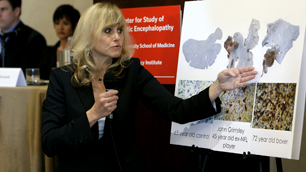Researchers Discover Brain Trauma in Sports May Cause a New Disease That Mimics ALS
Two former NFL players died after being diagnosed with Lou Gehrig’s Disease; New findings suggest they had a new disease associated with repetitive brain trauma
The Center for the Study of Traumatic Encephalopathy (CSTE) at Boston University School of Medicine (BUSM) and Department of Veterans Affairs (VA) announced today that they have provided the first pathological evidence that repetitive head trauma experienced in collision sports is associated with motor neuron disease, a neurological condition that affects voluntary muscle movements. The most common form of motor neuron disease is amyotrophic lateral sclerosis (ALS) or Lou Gehrig’s disease. The findings will be published in the September issue of the Journal of Neuropathology and Experimental Neurology.

The finding was discovered by Ann McKee, MD, and colleagues at the CSTE. McKee, a CSTE Co-Director, is an associate professor of neurology and pathology at BUSM, as well as Director of Neuropathology for the Department of Veterans Affairs at the Bedford VA Medical Center, where this research was conducted.
McKee and the CSTE researchers made this groundbreaking pathological discovery while examining the brains and spinal cords of 12 athletes donated by family members to the CSTE Brain Bank at the Bedford VA Medical Center. Three of these 12 athletes, including former professional football players Wally Hilgenberg and Eric Scoggins, as well as an unidentified former military veteran and professional boxer, developed motor neuron disease late in their lives. The former football players were diagnosed clinically with ALS, which is a progressive neurodegenerative disease that attacks motor nerve cells in the brain and spinal cord, resulting in muscle weakness and atrophy. ALS affects fewer than two in 100,000 patients annually, and 30,000 Americans currently live with the disease. The majority of ALS cases (90-95 percent) are considered “sporadic,” meaning of unknown cause, although it has long been suspected to involve a complex interaction between multiple genetic and environmental risk factors.
In this study, funded in part by an unrestricted gift from the National Football League (NFL) to the CSTE, McKee found that when they died, all 12 athletes showed neuropathological evidence of chronic traumatic encephalopathy (CTE), a progressive degenerative brain disease characterized by deposits of an abnormal form of tau protein and believed to be caused by repetitive head trauma.
In the three athletes with motor neuron disease, abnormal tau protein deposits were not only found throughout the brain, but also in the spinal cord. (See images here)
CSTE researchers also discovered that 10 of 12 CTE victims had a second abnormal protein, TDP-43, in their brains. Of those 10, only three had TDP-43 in the brain and the spinal cord, and those were the three athletes diagnosed with motor neuron disease. TDP-43 is also found in individuals with sporadic ALS although in the athletes with repetitive brain trauma, the TDP-43 pathology was more severe than found in sporadic ALS and was accompanied by extensive tau pathology. The brains and spinal cords of normal individuals show no TDP-43 or tau deposition.
These new findings suggest that the motor neuron disease that affected the three athletes is similar to, but distinct from sporadic ALS and represents a disease never described previously in the medical literature. This new disease, referred to as chronic traumatic encephalomyopathy (CTEM) by McKee and colleagues is likely caused by the repetitive head trauma experienced by athletes in contact sports.
The association between head trauma and ALS is supported by the medical literature, in which the risk of ALS has been reported to be higher among contact sport athletes and veterans. A study of professional soccer players in Italy found that the incidence rate of ALS was 6.5 times higher than in the general population. An increased incidence of ALS has also been reported in American football players, including three players from the 1964 San Francisco 49ers who died from ALS. Based on the number of retired NFL players with ALS, it is estimated that the risk is at least 8 times higher than in the adult male population. Among Veterans with a history of head injuries, their risk of ALS was 2.3 times higher than normal, and Gulf War Veterans have a twofold increased risk. In fact, since 2008, the US Department of Veterans Affairs has considered ALS as a presumptively compensable illness for all veterans. The discovery of this new ALS-like disease by the BU CSTE investigators suggests that one possible reason for the increased risk of clinically diagnosed ALS in veterans and in contact sport athletes may be the exposure to repetitive head trauma, including concussions, subconcussive blows and blast injuries.
These findings raise the question of whether head injuries may have contributed to Lou Gehrig’s motor neuron disease, and whether he also suffered from CTEM. Gehrig, nicknamed the “Iron Horse,” played football at Columbia University before becoming a legendary member of the New York Yankees and playing in 2,036 consecutive games, a record that stood for more than 60 years. Gehrig suffered at least five documented concussions and was reported to have been knocked unconscious for five minutes after taking a pitch to the head while not wearing a helmet. He played the next day.
“When we read reports about cases of the disease being linked to specific activities or experiences, such as the increased risk associated with military service, or this one regarding professional athletes, we are reminded of just how complex of a disorder ALS is. We’re hopeful that this new work may shed light on potentially exciting new possibilities for biomarker and therapy development,” said Steve Perrin, PhD, CEO and Chief Scientific Officer of the ALS Therapy Development Institute.
Responding to these new findings, Hunt Batjer, MD and Richard Ellenbogen, MD, the co-chairmen of the NFL’s new Head, Neck and Spine Committee, stated, “We are pleased that the NFL has provided the support necessary for this research and look forward to continued discussion of the findings within our medical committee and with other researchers to better understand their clinical implications.”
McKee now has analyzed the brains of more than 35 athletes and found evidence of CTE in 12 of 13 former NFL players. These brains were acquired primarily through the efforts of CSTE co-director Chris Nowinski who is also president of the non-profit Sports Legacy Institute. The CSTE maintains a registry of more than 350 living athletes who have agreed to donate their brain and spinal cord following death and to undergo telephone-based interviews and assessments during life. Robert Stern, PhD, CSTE co-director and an associate professor of neurology at BUSM, oversees the CSTE registry as well as a study about to begin of retired NFL players who undergo extensive neurological, cognitive, psychiatric, cerebrospinal fluid and neuroimaging studies. Robert Cantu, MD, a clinical professor of neurosurgery at BUSM and co-director of the CSTE, was recently appointed senior advisor to the NFL Head, Neck and Spine Committee.
Wally Hilgenberg died in 2008 at the age of 66 after a three-year battle with ALS. After graduating from the University of Iowa, Mr. Hilgenberg played 12 seasons with the Minnesota Vikings and three with the Detroit Lions as a linebacker.
Eric Scoggins died in 2009 at the age of 49 after a two-year battle with ALS. After graduating from the University of Southern California, he played one season for the San Francisco 49ers before playing two seasons in the United States Football League, for the Los Angeles Express and the Houston Gamblers.
Early symptoms of ALS often include increasing muscle weakness, especially involving the arms and legs, and progressive problems with speech, swallowing and breathing. Because voluntary muscle action is progressively affected, patients in the later stages of the disease may become totally paralyzed. In nearly all cases, ALS is fatal.

The CSTE was founded in 2008 and is the leading center in the world studying the long-term effects of repetitive brain trauma in sports and the military. The CSTE was created as a collaboration between Boston University (BU), Sports Legacy Institute (SLI) and the Department of Veterans Affairs. Co-directors of the BU CSTE include Robert Cantu, MD, a clinical professor of neurosurgery at BUSM, Ann McKee, MD, an associate professor of neurology and pathology at BUSM, Chris Nowinski, and Robert Stern, PhD, an associate professor of neurology at BUSM. The mission of the CSTE is to conduct state-of-the-art research of CTE, including its neuropathology and pathogenesis, the clinical presentation, biomarkers, and course, the genetics and other risk factors for CTE, and ways of preventing and treating this cause of dementia. Brain trauma is increasingly seen as a public health crisis due to the discovery of CTE in a number of recently deceased athletes, most of whom have been studied at the CSTE. McKee also identified CTE in the only former NHL player examined, Reggie Fleming. The CSTE’s groundbreaking research created a dramatic change in the understanding of and response to brain trauma and concussions in all sports, especially football. The BU CSTE has received grants from the National Institute on Aging and the National Operating Committee on Standards in Athletic Equipment (NOCSAE), and has received an unrestricted gift from the NFL.

CTE, originally referred to as “dementia pugilistica” because it was believed to only affect boxers, is a progressive brain disease believed to be caused by repetitive trauma to the brain, including concussions and subconcussive blows. It is characterized by deposits of an abnormal protein called tau in the form of neurofibrillary tangles, glial tangles, and neuropil threads throughout the brain, and, in some cases, the presence of another abnormal protein – associated with motor neuron disease – known as TDP-43. These abnormal proteins are associated with the impaired functioning and eventual death of brain cells. Early on, CTE sufferers may display symptoms such as memory impairment, emotional instability, erratic behavior, depression and problems with impulse control. CTE may eventually progress to full-blown dementia. Although similar to Alzheimer’s disease, CTE is pathologically distinct, and it is the only known preventable cause of dementia.
CSTE co-directors Cantu, McKee and Nowinski serve on the NFL Players Association Mackey/White Traumatic Brain Injury Committee, which includes, and is chaired by, CSTE registry member Sean Morey. In addition, Cantu serves as a senior advisor to the newly created NFL Head, Neck and Spine Committee.